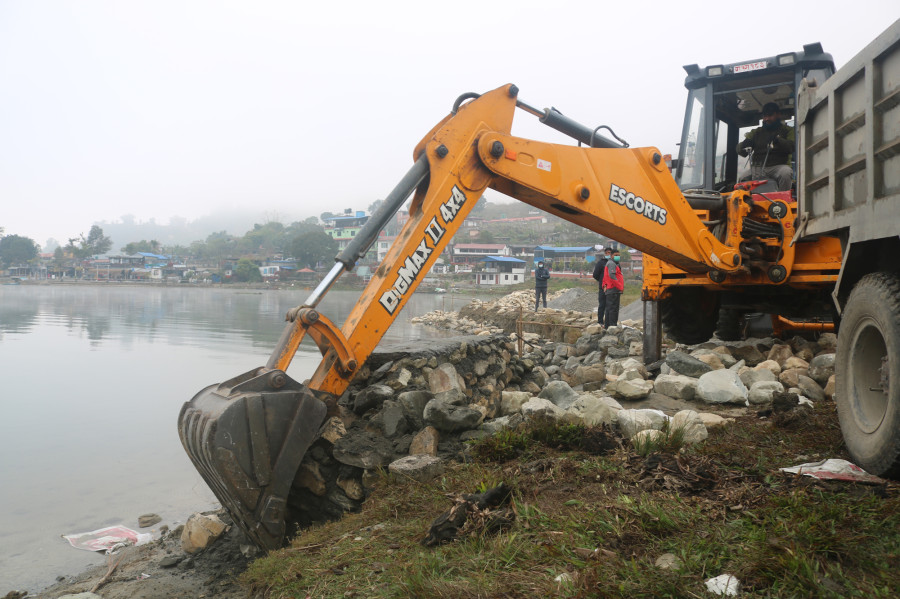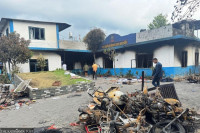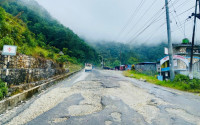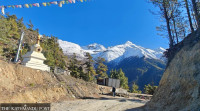Gandaki Province
Pokhara Metropolis demolishes new structures constructed around Phewa Lake
In 2007, authorities had decided not to allow any concrete structures to be built within 65 metres of the lake.
Pratiksha Kafle
Pokhara Metropolitan City has demolished structures that were recently built in Khapaudi by breaching the Phewa Lake Conservation Guidelines.
Dipesh Shrestha, a businessperson in Pokhara, on Friday started the construction of a restaurant on nine ropanis of land that he had leased from Khagaraj Acharya, a local resident. The metropolis bulldozed the walls constructed on the site on Saturday and Sunday.
“We informed the metropolitan city about the structures being built against the conservation guidelines and asked for a dozer to pull down the structures. The structures were demolished in the presence of the metropolitan police, local residents, Nepal Police and representatives of the local unit,” said Ran Bahadur Thapa, the chairman of Pokhara Metropolis Ward No 18.
The land where the structures were built is on the banks of Phewa Lake. According to the ward chief, Acharya used to collect rent from various paragliding companies for letting them use the land as a landing site.
According to the people’s representatives, the construction of the structures goes against the Phewa Lake Conservation Guidelines.
“We have to remove the structures to conserve the lake, which is our identity. We had demolished the structures on Saturday but it was rebuilt overnight so we had to bulldoze it again on Sunday,” said Thapa.
The Phewa Lake Conservation Guidelines of the Physical Infrastructure Development Master Plan formulated in 1976 included an area along the lake as Phewa Conservation Area. In 2007, the Kaski District Council and the Pokhara Valley Town Committee decided not to allow any concrete structures to be built within 65 metres of the lake.
The Supreme Court in April 29, 2018, had issued an order to the federal government to immediately remove buildings and business establishments built within 65 metres from the lake’s edge and acquire the land for the conservation of Phewa Lake.
However, the construction of illegal structures within 65 metres of the lake has continued unabated, as the Supreme Court’s verdict is yet to be implemented, says Thapa. Two structures were built just 40 metres west from Acharya’s land a month ago. According to the office of Ward No 18, as many as 10 structures were constructed in the area within the past six months.
“The construction of physical structures around the lake area by violating the conservation guidelines poses a huge threat for the lake’s conservation,” said Thapa. “We must put a stop to it.”
According to Thapa, Shrestha and four of his friends plan to set up a restaurant on 16 ropanis of land in the area. Among the total land, nine ropanis fall within 65 metres from the lake.
In May 2012, a panel led by Bishwa Prakash Lamichhane, former chair of city development committee of Pokhara, had prepared and submitted its report to then prime minister Baburam Bhattarai. The Lamichanne report recommended that around 540 ropanis (27 hectares) of private land in the northwestern part of Phewa lake should be acquired by the government to conserve the wetland around the lake which the Supreme Court’s ruling in 2018 upheld.
Meanwhile, people who have their private properties within 65 metres of the lake have their own grievances. Many of them complained that they have not been able to put their private land to use nor has the government acquired the land with compensation.
“The government should acquire the private land around the lake by providing compensation to the landowners. But it seems reluctant to crack down on structures being built within 65 metres of the lake,” said Bhupal Singh Dhakal of Pokhara-18. According to him, the lake is shrinking year by year and the authorities concerned are indifferent to its conservation.
The Lamichhane report mentions that Phewa lake had a total area of 12,874 ropanis (around 655 hectares), including 9,955 ropanis covered by water, 652 ropanis of wetland, 2,101 ropanis of cultivable land and 165 ropanis of public land.
In 1957, according to a Nepal-India cooperation mission survey, the lake covered an area of 10 square kilometres. There have been periodic surveys since then and each found the lake’s area shrinking. The last one by the government survey team in 2007 found the lake measured a mere 4.2 square kilometres. According to geologists, there were mainly two reasons for this: the siltation deposited by around 50 rivulets that feed the lake on its western edge and human encroachment.




 16.57°C Kathmandu
16.57°C Kathmandu.jpg)










